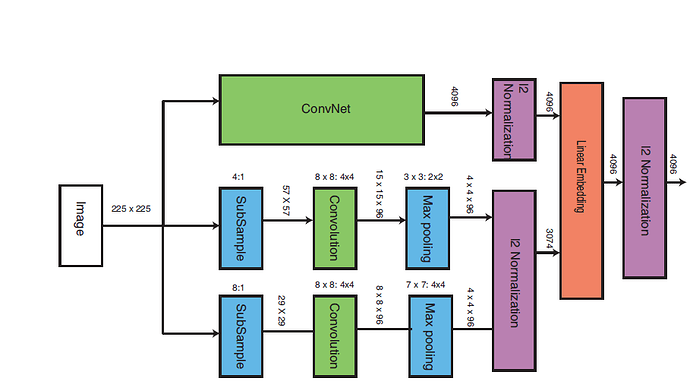Hi,
I’m trying to implement the given network (Deep Ranking) in PyTorch.
Here is the Keras and Tensorflow equivalent to it.
def convnet_model_():
vgg_model = VGG16(weights=None, include_top=False)
x = vgg_model.output
x = GlobalAveragePooling2D()(x)
x = Dense(4096, activation='relu')(x)
x = Dropout(0.6)(x)
x = Dense(4096, activation='relu')(x)
x = Dropout(0.6)(x)
x = Lambda(lambda x_: K.l2_normalize(x,axis=1))(x)
convnet_model = Model(inputs=vgg_model.input, outputs=x)
return convnet_model
def deep_rank_model():
convnet_model = convnet_model_()
first_input = Input(shape=(224,224,3))
first_conv = Conv2D(96, kernel_size=(8, 8),strides=(16,16), padding='same')(first_input)
first_max = MaxPool2D(pool_size=(3,3),strides = (4,4),padding='same')(first_conv)
first_max = Flatten()(first_max)
first_max = Lambda(lambda x: K.l2_normalize(x,axis=1))(first_max)
second_input = Input(shape=(224,224,3))
second_conv = Conv2D(96, kernel_size=(8, 8),strides=(32,32), padding='same')(second_input)
second_max = MaxPool2D(pool_size=(7,7),strides = (2,2),padding='same')(second_conv)
second_max = Flatten()(second_max)
second_max = Lambda(lambda x: K.l2_normalize(x,axis=1))(second_max)
merge_one = concatenate([first_max, second_max])
merge_two = concatenate([merge_one, convnet_model.output])
emb = Dense(4096)(merge_two)
l2_norm_final = Lambda(lambda x: K.l2_normalize(x,axis=1))(emb)
final_model = Model(inputs=[first_input, second_input, convnet_model.input], outputs=l2_norm_final)
return final_model
I’m confused about multiple things.
- How to merge layers in Pytorch like they did in Keras.
- How can I provide the same input image to 3 different networks
- Any other mistakes I’m making while implementing this network in PyTorch
Also, can you please walk me through pytorch implementation of same. I’ve written few lines of code. I’ve used resnet instead of VGG
model_conv = torchvision.models.resnet50(pretrained=True)
num_ftrs = model_conv.fc.in_features
model_conv.fc = nn.Linear(num_ftrs,2000)
class Network(nn.Module):
def __init__(self):
super().__init__()
self.conv1 = nn.Conv2d(3,96,8, stride=16,padding=1)
self.maxpool1 = nn.MaxPool2d(3,4,padding=1)
def forward(self,x,y,z):
x = model_conv(x)
y = self.conv1(y)
y = self.maxpool1(y)
y = F.normalize(y,dim=1,p=2)
z = self.conv1(z)
z = self.maxpool1(z)
z = F.normalize(z,p=2, dim=1)
return x
test = Network()
